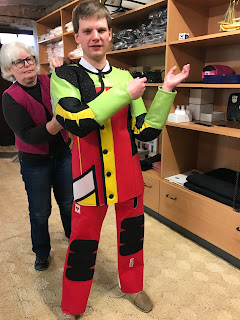After a few days of blog admin updates, back to information about shooting equipment. This post will be of particular interest for users of the EcoAims VIS500 as I will be discussing the EcoAims software.
Over the last couple of weeks I have helped a couple of friends with their EcoAims VIS500 aiming devices and the software. This reminded me about the situation with the software and I think it might be useful to give some tips here for everyone. There are two pieces of software for the VIS500, the training software and the setup tool.
The training software
The training software allows the computer to show where the gun is pointing and will estimate the score of shots. This means you can use your EcoAims VIS500 as an electronic trainer and do dry-fire training. Whilst this may seem like a nice feature, unfortunately in reality it is not of great value:
- The software is not really accessible with a screen reader and so those who rely on a screen reader will only be able to hear the shot score at the time of taking the shot. You will not even be able to configure software settings. To get the most from the software you probably will want sighted assistance.
- Sighted people tell me that even when you can see, the information available is very limited in comparison to what is provided in other electronic trainers, for example Scatt. When using Scatt, there is an amazing amount of statistics available, enough to confuse many people but in the right hands a really valuable resource to allow you detailed analysis of your shooting.
My recommendation is, if you want serious electronic training, then you will need to buy something else.
The VIS500 setup tool
Thankfully as it is more important, the setup tool can be used by a screen reader user independently, however this is still not entirely issue free as some of the labelling of the controls is not correctly read. If you know the order of the controls as you tab around the window, then you will be able to access everything.
Below is a description of the user interface for version 1.1.
IMPORTANT: Remember to press the read parameters button to retrieve the settings from the VIS500. When you have finished changing the settings, remember to press the set parameters button to save the settings back to the aiming device. Failing to press the button to set the values will lead to no changes in the device settings.
The sound tab
- On time edit box; the length of time the pulsed tone will be on, the length of the pulse.
- Off time edit box; the length of time the pulsed tone will be off, or the time between pulses.
- Off amplitude edit box; how lound the tone will be for the off part of the pulsed tone. Low values will be quieter and high values will be louder.
- Pulse region; whether you want the tone to pulse inside or outside the zone. Select inside to have it pulse near the target centre, select outside to have it pulse near the target edge.
- Pulse zone size slider; Select how large you want the zone for the pulsed tone to be.
Sound curve tab
This tab only consists of three radiobuttons to select between three different sound curves, A, B or C. A sound curve is how the pitch varies relative to the centre. I have not found a description for the different sound curves and I can only recommend try them all and select which you prefer or shoot best with.
Sensor tab
On this tab there is just one slider to set the sensitivity of the shot sensor. Lower values make the scope less sensitive and higher values make it more sensitive. I found that normally only one or two values works well for a particular rifle, correctly detecting shots whilst not incorrectly detecting other bumps and clicks.
Software version tab
This allows you to check the version of the software installed in the VIS500. Unfortunately if you have an old version you would need to send it to EcoAims or may be a dealer to get the software updated.
Using it with a Mac
EcoAims have no version of the software for MacOSX. Users of those computers will need to either:
- Install windows on their Mac, through virtual machine software such as VmWare or directly with BootCamp
- Alternatively find a Windows PC, even a fairly cheap PC should run the software as it is not very heavy on resources.
Even if there were software for MacOSX, the experience may not be too good. I once had my VIS500 connected to my Mac when it booted into MacOSX and it seems like VoiceOver was getting input events from the VIS500, as if it thought the VIS500 was a Braille display or something, which was sending VoiceOver crazy. When I disconnected the VIS500 VoiceOver went back to normal. I doubt this can be corrected by EcoAims without entirely redesigning how the VIS500 communicates with the computer.














